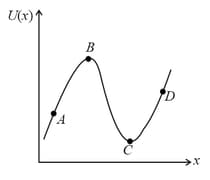EASY
Earn 100
The potential energy of an object is , where is the position in meter. The position at which the force becomes zero is
(a)
(b)
(c)
(d)
50% studentsanswered this correctly
Important Questions on Work, Energy and Power
MEDIUM
EASY
EASY
EASY
MEDIUM
MEDIUM
EASY

MEDIUM
MEDIUM
MEDIUM
The graphs below show the magnitude of the force on a particle as it moves along the positive -axis from the origin to . The force is parallel to the -axis and conservative. The maximum magnitude has the same value for all graphs. Rank the situations according to the change in the potential energy associated with the force, least (or most negative) to greatest (or most positive).

EASY
MEDIUM
EASY
MEDIUM
| Column-I | Column-II | ||
| (a) | (i) | ||
| (b) | (ii) | ||
| (c) | (iii) | ||
| (d) | (iv) | ||
HARD
EASY

EASY
EASY
EASY
HARD

